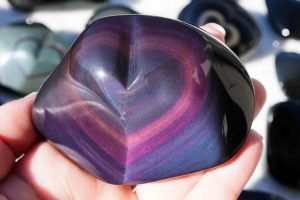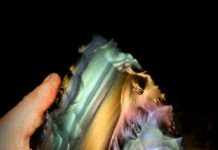
Obsidian is a natural volcanic glass that is formed as an igneous rock that is extrusive.
Obsidian is formed by rapidly cooling felsic lava extruded from a volcano with limited growth in crystals. It is commonly found in the margins of rhyolitic lava flows known as obsidian flows, where the chemical composition (high silica content) creates a high viscosity resulting in the production of natural glass from the lava after rapid cooling. This highly viscous lava’s inhibition of atomic diffusion explains the lack of crystal growth. Obsidian is rough, fragile, and amorphous, with very sharp edges breaking. It was used in the past for the manufacture of cutting and slicing equipment and was used experimentally as surgical scalpel blades.
Obsidian is mineral-like, but not a true mineral because it is not crystalline as a glass; however, it is too complex to be categorized as a mineral. It is classified as a mineraloid sometimes. While obsidian is usually dark in colour, similar to basalt-like mafic rocks, the composition of obsidian is extremely felsic. Obsidian mainly consists of SiO2 (silicon dioxide), typically 70% or more. With a similar composition, crystalline rocks include granite and rhyolite. Because obsidian is metastable on the surface of the Earth (the glass forms fine-grained mineral crystals over time), no obsidian older than the Cretaceous period has been found. The existence of water speeds up this process of obsidian. Although the newly formed obsidian has a low water content, usually less than 1 percent by weight, it is slowly hydrated to form perlite when exposed to groundwater.
How to Identify Obsidian?
How can you identify obsidian ? The lack of a crystalline structure indicates that obsidian is not a true mineral and causes extreme sharpness of the fracture surfaces. Since prehistoric times, obsidian has been used in cutting tools and is still used today in surgical scalpels.
Explore obsidian where cooling is rapid in the margins of lava flows. Glass Buttes in central Oregon is one of the best places to find obsidian in the U.S. Pieces of fist size can be found on the surface in abundance here.
Examine the obsidian’s general presence. It has a distinctive appearance of smooth glass. Obsidian is a frozen liquid that contains small amounts of mineral impurities.
See the color Because pure obsidian is usually dark, on rare occasions it may also be almost white.
Consider the effect of impurities on the obsidian color For examples, iron and magnesium may make obsidian dark green. Hematite or limonite add a red or brown color to the obsidian. A lot of microscopic rock and mineral particles usually cause the jet black color most closely associated with obsidian.
Looking at the obsidian’s visual effects of small gas bubbles. It can cause the obsidian to have a gold or silver shine if the bubbles were spread almost flat.
What does Obsidian feel like?
Obsidian has a strong conchoidal fracture and luster. It means that the top of the fracture is curving smoothly (like a seashell). Obsidian appears to be black. Minute inclusions and tiny crystals in the glass create it hue.
What are the characteristics of obsidian?
Obsidian breaks with a typical “conchoidal” fracture, like all glass and some other forms of natural rocks. Due to the near absence of mineral crystals in the glass, this smooth, curved form of fracture surface occurs. Conchoidal fracture surface intersections may be sharper than a knife.
What is the texture of obsidian?
Obsidian, igneous rock that occurs as a natural glass produced by the rapid refreshment of viscous volcanic lava. Obsidian is extremely silica-rich (around 65 to 80 percent), low in water, and has a rhyolite-like chemical composition. Obsidian has a luster of glass and is somewhat stronger than window glass.










